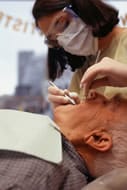Dental Caries and Tooth Loss in Adults in the United States, 2011–2012
Posted on by Dental caries and tooth loss are important oral health indicators for adults and are key measures for monitoring progress toward health promotion goals set by Healthy People 2020. Although tooth decay and complete tooth loss have been declining in the United States since the 1960s, disparities have remained between some groups. As adults age, oral health-related quality of life is negatively affected by tooth loss and decay.
Dental caries and tooth loss are important oral health indicators for adults and are key measures for monitoring progress toward health promotion goals set by Healthy People 2020. Although tooth decay and complete tooth loss have been declining in the United States since the 1960s, disparities have remained between some groups. As adults age, oral health-related quality of life is negatively affected by tooth loss and decay.
A new NCHS report describes U.S. adult dental caries and tooth loss by age and race and Hispanic origin for 2011–2012.
Key Findings from the Report:
- Among adults aged 20–64, 91% had dental caries and 27% had untreated tooth decay.
- Untreated tooth decay was higher for Hispanic (36%) and non-Hispanic black (42%) adults compared with non-Hispanic white (22%) and non-Hispanic Asian (17%) adults aged 20–64.
- Adults aged 20–39 were twice as likely to have all their teeth (67%) compared with those aged 40–64 (34%).
- About one in five adults aged 65 and over had untreated tooth decay.
- Among adults aged 65 and over, complete tooth loss was lower for older Hispanic (15%) and non-Hispanic white (17%) adults compared with older non-Hispanic black adults (29%).
Posted on by
Categories dental caries
Page last reviewed: May 14, 2015
Page last updated: May 14, 2015
Content source:
CDC, National Center for Health Statistics

